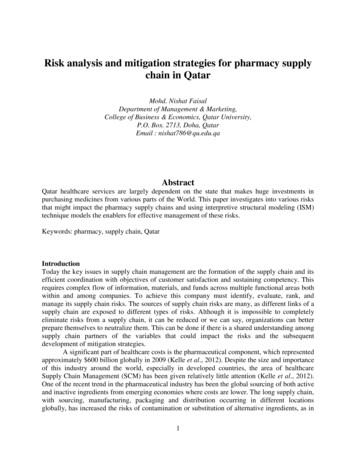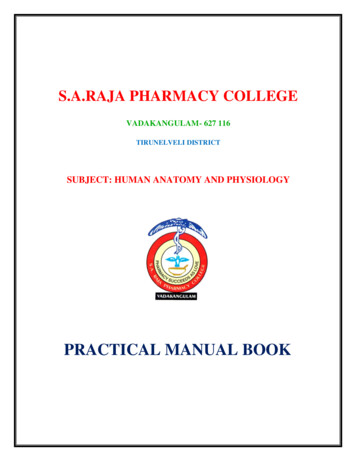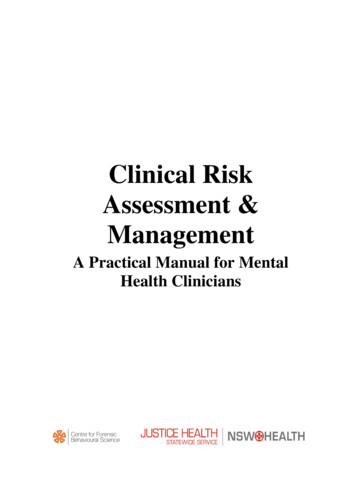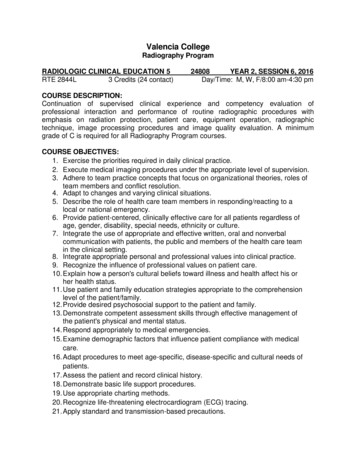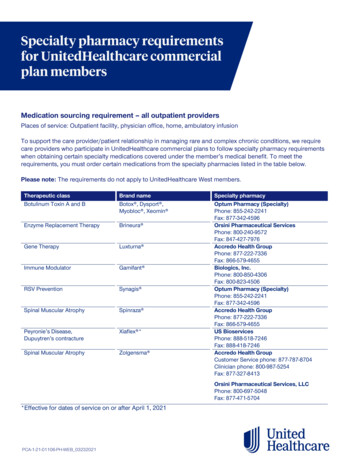
Transcription
COLLEGE OF CLINICAL PHARMACY RISKMANAGEMENT PLAN2019-2023
1Table of ContentsSECTIONTable of contentsPAGE1List of Tables2List of Figures2List of Annexures2Abbreviations3Glossary41. INTRODUCTION71.1 AN OVERVIEW ON COLLEGE71.2 VISION, MISSION AND VALUES91.3 ORGANISATIONAL STRUCTURE102. RISK MANAGEMENT PROGRAM102.1 PURPOSE112.2 OBJECTIVES112.3 SCOPE112.4 APPROACH112.5 PROCESS12Step 1: Establish Context (of Risk)13Step 2: Risk Identification -Risk Categories –Hemaya & HSE13Step 3: Risk Analysis16Step 4: Risk Evaluation17Step 5: Risk Treatment19Step 6: Communication and consultation20Step 7: Monitoring and review (Risk register)202.6 ADMINISTRATION202.6.1 ROLES AND RESPONSIBILITIES212.7 BUILDING RISK MANAGEMENT CULTURE22ANNEXURES24REFERENCES371 Page
2List of TablesNo1TitleRisk Categories and DescriptionPage No.2Assessment of Likelihood (Incident)163Risk Impact - Consequence Score174Risk Rating Action Guide (Treatment of Action)1914List of FiguresNo1TitleRisk Management ProcessPage No.2Risks Categories Identified in COCP133Risk Assessment Matrix / Risk Heat Map184Organogram of Risk Management (COCP)2012List of AnnexuresNo1TitleHemaya - Electronic Incident Reporting Form2Hemaya - Electronic Incident Reporting System-Flow Chart303Appointment of Risk Management Committee314Appointment of Risk Management Officer335Health, Safety and Environment (Checklist)346Risk Register362 PagePage No.24
ge of Clinical PharmacyDeanship of Quality and Academic AccreditationEIRSElectronic Incident Reporting SystemIAUImam Abdurrahman Bin Faisal UniversityISOInternational Organization for StandardizationKSAKingdom of Saudi ArabiaRMRisk ManagementRMCRisk Management CommitteeRMHRisk Management HandbookRMORisk Management OfficerRMSRisk Management SystemRMPRisk Management ProgramRMURisk Management UnitRTAPRisk Treatment Action PlanRCARoot Cause AnalysisVDQVice Dean Quality3 Page
4GlossaryTermDescriptionRiskEffect of uncertainty on the achievement of objectives.IncidentNear-missAdverse eventSentinel eventIncident reportIncident report systemAny accident, event or circumstance that led to harm, loss or damage topeople (student, faculty, staff, visitors, and/or facility), property, reputation,or other occurrence that could impact on the university’s ability to achieveits objectives.Any process variation that did not affect an outcome but for which arecurrence carries a significant chance of a serious adverse outcome.An unanticipated, undesirable, or potentially dangerous occurrence in anorganization.Sentinel events are unexpected events that result in serious physical orpsychological injury. Examples of the most commonly occurring sentinelevents happening in university which ranges from person falling on premisesleading to serious physical injuries /harassment /violence/death or evenpsychological injury – which signal the need for immediate investigation andresponse.An incident report is an official report taken by faculty, staff and students ofcollege to document information about an incident.A system used to document the details of an incident. It is a primarycommunication mechanism used to identify events or situations that maypresent liability exposure.Risk RegisterIt is a record of the details of all risks that have been identified along withtheir analyses and plans for how those risks will be treated.Risk ManagementPlanned and systematic approach to identification, evaluation and controlof risk.Risk ManagementpolicyA statement which expresses the University’s commitment to riskmanagement and clarifies its general direction or intention. Typically, itincludes a description of the risk management framework, roles andresponsibilities, annual cycle, definitions etc.Risk IdentificationProcess of finding, recognizing and describing risks.Risk AnalysisRisk EvaluationRisk Assessment4 PageProcess that is used to understand the nature, sources, and causes of riskthat is identified and to estimate the level of risk. It is also used to studyimpacts and consequences and to examine the controls that currentlyexists.Process that is used to compare the risk analysis results with risk criteria inorder to determine whether a specified level of risk is acceptable ortolerable.Overall process of risk identification, analysis and evaluation.
5Risk LikelihoodRisk ConsequenceThe chance that something might happen-can be defined, determined, ormeasured objectively or subjectively and can be expressed eitherqualitatively or quantitatively (using mathematics).It is the outcome of an event and has an effect on objectives. Single eventcan generate range of consequences which can have both positive andnegative effects on objectives. Initial consequences can also escalatethrough cascading and cumulative effects.Raw RiskRisk score obtained before treatment of risk.Residual RiskRisk remaining after risk treatment.Risk Severity- HeatMap MatrixA matrix on which the level of risk consequence and likelihood are plottedto determine risk severity.Risk ScoreA score, based on a combination of consequence and likelihood andderived from the risk heat map, representing level or magnitude ofrisk, and used primarily to prioritize risks.Risk AssessmentMatrixA tool that combines a heat map with criteria for risk analysis.Root Cause AnalysisRisk TreatmentRisk ControlRisk MonitorRisk ReviewRisk OwnerRisk ManagerRisk Coordinator5 PageA process for identifying the basic or causal factors that underliesvariations in performance, including the occurrence or possibleoccurrence of sentinel event (incident is severe risk in nature). AnRCA focuses primarily on systems and processes and not individualperformanceProcess of selecting and implementing or modifying controls tomanage risk.Risk controls include any process, policy, device, practice, or otheractions which modify risk. A control is any measure, operated by theorganization, intended to modify a risk.Process of continual checking, critically observing, or determiningthe status of a risk, control or risk management process in order toidentify needed change.An activity to determine the suitability, adequacy and effectivenessof what is being done by the entity to achieve risk managementobjectives.A person or entity with the accountability and authority to manage arisk.Person responsible for administering an organization’s overall riskmanagement framework. Specific person is assigned to monitoreach risk (for example X will be responsible for all the health andsafety risks while Y will be responsible for strategic risks) or morethan one risk, based on the risk category.Person responsible for administering risk management activities fora specific risk on behalf of a risk owner.
6Risk appetiteRisk ManagementPlanRisk ManagementFrameworkAmount and the type of risks that an organization is willing to pursue orretain.Scheme within the risk management framework specifying theapproach, the management components and resources to be applied tothe management of risk.Set of components that provide the foundations and organizationalarrangements for designing, implementing, monitoring, reviewing andmitigating risks.Risk profileDescription of any set of risks.Risk DescriptionA structured description of a risk, which separates cause, event andconsequences. It is an elaboration of the short-form risk event title,intended to provide a short summary of the risk.6 Page
71. INTRODUCTION1.1 COLLEGE OVERVIEWThe College of Clinical Pharmacy (COCP) was established by the Royal Decree no.5088/MB dated 7/8/1432H (8/7/2011CE). The College has since then strived to deliverthe high-caliber PharmD program for pharmacy students in 1434/1435H (2013/14CE).The College has a six-year PharmD program. The program is structured in the semestersystem with the total of 177 credit hours and the medium of instruction is English.The first cohort of pharmacy students was enrolled in the program in the academicyear of 2013/2014 with 11 male and 26 female students. A total 193 graduates (i.e. 77males and 116 females) from the program and most of them have been employed byacademia, hospitals, community pharmacies and pharmaceutical industry. Currentlythe total number of students enrolled in the program is 319 students (i.e. 140 malesand 179 females), in addition to 87 interns (i.e. 35 males and 52 females).Department of Pharmacy practiceThe Department of Pharmacy Practice seeks to be a leader in pharmacy education,research and community services. The department provides the basic and advancedcoursework in clinical practice, social and administrative pharmacy and practical skillstraining components of the curriculum that makes Doctor of Pharmacy graduates ableto deliver effective and cost-efficient pharmaceutical care. Students can acquire theknowledge and skills in different specialties of clinical pharmacy and pharmacypractice such as drug information, internal medicine, critical care, ambulatory care,cardiology, infectious disease and clinical pharmacokinetics pharmacoepidemiology,pharmacoeconomics and pharmacy management.The Department of Pharmacy Practice contributes to the Imam Abdulrahman BinFaisal University’s research missions through collaborations with colleagues fromother departments in the college, other colleges at IAU and other health institutionsinside and outside the KSA. Our faculty, interns and students are developing andconducting cutting edge research focusing on the improvement of patient care,medication safety and efficacy, adherence and the health-related quality of life.7 Page
8The Department of Pharmacy Practice contributes to the community service missionthrough serving the community. The faculty, intern and students are engaged indifferent community services including promoting the awareness about differentmedications and other activities. These community campaigns targeted students inthe schools, public in the malls and patients in the hospitals.Department of PharmaceuticsPharmaceutics is the discipline of pharmacy that deals with all aspects of theconversion of new effective drugs or old drugs to pharmaceutical forms to be usedsafely, effectively and appropriate for the patient, both in factories or pharmaceuticalpreparation laboratories, which is safe, effectiveThe Department of Pharmaceutics seeks to improve the educational process of thePharm D program by contributing to the improvement of the quality ofpharmaceutical educationThe courses offered by the department focus on basic pharmaceutical knowledge andskills like, fundamental and physical pharmacy, dosage forms design,biopharmaceutics and pharmaceutical quality control. Advanced courses alsodelivered like pharmacokinetics, new drug delivery systems and pharmaceuticaltechnology, as well as the study of the principles of good manufacture practice inpharmaceutical industry.The department implements several teaching methods including the use of the WebPrograms.The department contributes to the research activities of the college by utilizing thestate-of-the-art research laboratory which houses different instrumentation such asdifferential scanning calorimetry, particle sizer analyzer with zeta potential,automated dissolution system, tableting machine and automated Transdermaldiffusion tester and covering the new research areas like nanoparticles.The faculty members actively participate in community services and campaigns toincrease the awareness of people about the rational drug use and the optimum use ofmedications.Department of pharmaceutical chemistrySince the date of its establishment, the Pharmaceutical chemistry department workswith other college departments in preparing pharmacists working in all regions of theKingdom and in all branches of the pharmaceutical and health profession includingcommunity, hospital, and industry.8 Page
9In addition, courses at the chemistry department contributes to a high extent indeveloping the required skills for the college graduates especially those who aim towork in pharmaceutical industry and research and development.The Pharmaceutical Chemistry department provides learning experiences based onthe best educational practices for all students in different chemistry subjectsincluding, organic chemistry, medicinal chemistry, drug design, pharmaceuticalanalytical chemistry. These courses emphasize fundamental understanding in thephysical, chemical, and biological processes of drugs and drug-related systems, andinnovated therapies as well as pharmaceutical analysis and quality control.The department is dedicated to support excellence in pharmaceutical chemistryeducation. We are committed to teaching all pharmaceutical chemistry subjectsthrough strong innovative teaching modules. The department is continuouslyreviewing its course specs and is always utilizing various teaching and learningstrategies that make their students the hub of the learning process and that areintegrated with properly aligned assessment plans.Moreover, the department is well established with several laboratories equipped withstate-of-the-art instrumentation. The faculty members have conducted cutting edgescientific research in the fields of medicinal chemistry, drug discovery, pharmaceuticalanalytical chemistry, and organic chemistry. The department has attracted fundingfrom various organizations and is producing a high number of research articlespublished in distinct and high impact peer reviewed scientific journals.Faculty members of the department are also contributing in the students’ graduationprojects.Courses assigned by Pharmaceutical Chemistry department are importantcomponents of the PharmD curriculum and represent essential foundation for othercourses in the Pharm D program in areas such as pharmacology and pharmacypractice.Our faculty members actively participate in all community services and campaigns thatare held by the college, and work hardly to implement consultancy services to thedifferent pharmaceutical sector in t
the status of a risk, control or risk management process in order to identify needed change. Risk Review An activity to determine the suitability, adequacy and effectiveness of what is being done by the entity to achieve risk management objectives. Risk Owner A person or entity with the accountability and authority to manage a risk. Risk Manager
